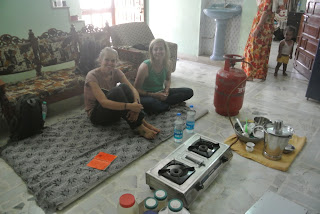Our cooking class takes place in the home of a farming family just out side of old town Udaipur. Our teacher, Vijay, picks us up with his brother on their motorbikes. From what I can gather Vijay and his family also live with his brother's family and his parents. The house consists of a large but fairly empty sitting room with four rooms leading off it, one of which is a kitchen. The other three are bedrooms, which are all very neat but very full. As well as huge beds they each contain a fridge and small cooker, shelves with pots and pans, a tv, sofas, a table, toys, shrines and general stuff. Although it is normal for extended families to live together in India, I get the impression from these room that they still attempt to have some privacy. It odd to imagine each group sitting on their seperate rooms wathing tv and eating dinner with the door closed.
Above: Vijay's sitting room arranged for our lesson
Vijay begins by teaching us about the different spices used in Indian cooking. He opens a round, silver coloured tin containing seven smaller tins filled with spices. He asks what each of them are in turn. We manage to identify coriander, cumin, tumeric, garamasala, salt and chilli, but not aniseed. Any Indian dish can be made with these spices, and every family has a spice tin which is passed down through the generations. I wonder which brother gets this one. Other important ingredients in Indian cooking are onion and garlic paste, freah coriander, chickpea flour, fresh chillis and tomatoes.
Above: Spice Tin
Above: Vegetable Pakoras
We next make one of my favourie dishes, dal fry, from lentils and more spices from the tin. Then chana (chickpea) masala, vegetable curry, a Rajastani rice dish called 'khichdi' - which tastes alot like veg-fried rice and finally aloo (potato) stuffed paratha, plain paratha and plain chipatti. The paratahs and chipattis are made from a chickpea flour dough and are pretty much the same except that parathas are cooked with oil, and chipattis dry, causing air bubbles to form.
Above: Chana masala, dal fry and khichdi rice
Above: Plain Paratha
Above: Stuffed Aloo Paratha
Finally we make my favourite Indian pudding - Gulab Jamun. I have had these a lot and always thought that they must be difficult to make, so I am interested to learn how it is done. 'Solid milk' (I'm not sure what this is but it looks like milk powder mixed with more milk), is kneeded together with white flour before being rolled into balls and deep fried. After they have puffed up and turned golden brown, they are removed from the oil, drained and soaked in sugar syrup. Simple. It is delicious served cold with ice cream. Alex and Charlotte are both feeling ill from the heat, which means I get to eat as much as I want, but its too much and most of it get packed up for us to take back for our dinner.
Above: Gulab Jamun
Above: Vijay







Sounds like a good experience. The little pudding balls sound like mandazis that you get in Kenya. Luv Murv
ReplyDeleteThere is a spice tin in the parcel on its way home - I couldn't resist! XX
ReplyDelete